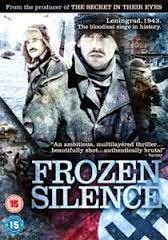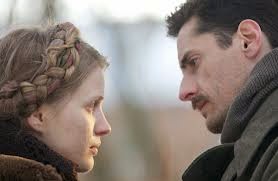 During World War II the
Spanish dictator Franco, wishing to repay the kindness shown by Nazi
Germany during the Spanish Civil War, organised a full division of
volunteers (Division Azul, or the Blue Division) who served in the
Wehrmacht, with the proviso they would only fight on the eastern
front against the godless Bolsheviks, and not again Spain's western
European neighbours. Although their name came from the distinctive
blue uniform blouses, a hold-over from the Falangists, in the field
they fought in German uniforms.
During World War II the
Spanish dictator Franco, wishing to repay the kindness shown by Nazi
Germany during the Spanish Civil War, organised a full division of
volunteers (Division Azul, or the Blue Division) who served in the
Wehrmacht, with the proviso they would only fight on the eastern
front against the godless Bolsheviks, and not again Spain's western
European neighbours. Although their name came from the distinctive
blue uniform blouses, a hold-over from the Falangists, in the field
they fought in German uniforms.
This little-known bit
of history forms the background to the 2011 Spanish film Frozen
Silence (in Spanish, Silencio en la Nieve, Silence in the
Winter, not as good a title), set in 1943, as the Blue Division takes
part in the siege of Leningrad. In the midst of the terrible Russian
winter, a body turns up with its throat slashed and an inscription
carved into its chest. As it happens, one of the privates on hand,
Arturo Andrade (Juan Diego Botto) was a police detective, and he is
soon given the assignment to find the killer. Who soon, as it
happens, turns into a serial killer. Is he a hidden 'red'? A mason
conducting some weird ritual? Or is something else, perhaps more
sinister, going on?
The strongest part of
the film is the setting, particularly the opening, when the body is
discovered in the midst of group of horses frozen in a lake.
Occasionally in the film there are shots of stark contrast, of cold
power, but sadly, not often enough.  That mirrors the basic problem of
the movie: it's a who-dun-it whose plot is very much
mechanical—hence, the action often bogs down into Andrade, and his
sympathetic sergeant Espinoza (Carmelo Gomez), travelling back and
forth along the front, asking questions, and travelling back.
That mirrors the basic problem of
the movie: it's a who-dun-it whose plot is very much
mechanical—hence, the action often bogs down into Andrade, and his
sympathetic sergeant Espinoza (Carmelo Gomez), travelling back and
forth along the front, asking questions, and travelling back.
 That mirrors the basic problem of
the movie: it's a who-dun-it whose plot is very much
mechanical—hence, the action often bogs down into Andrade, and his
sympathetic sergeant Espinoza (Carmelo Gomez), travelling back and
forth along the front, asking questions, and travelling back.
That mirrors the basic problem of
the movie: it's a who-dun-it whose plot is very much
mechanical—hence, the action often bogs down into Andrade, and his
sympathetic sergeant Espinoza (Carmelo Gomez), travelling back and
forth along the front, asking questions, and travelling back.
A serial killer on the
loose might have been pushed over the edge by the horrors of war, or
by the grinding assault of winter itself; for Andrade, trying to
manoeuvre through the military bureaucracy while dealing with the
brutal murders, might be enough to push himself over the edge as
well. But we never get that far, and, oddly enough, combat is kept in
the distance. The winter itself comes and goes: conditions seem
arctic at times, at other times it's a very mild sunny time, which
might herald the return of spring and fighting,  but I'm not sure any
such symbolism was intended.
but I'm not sure any
such symbolism was intended.
 but I'm not sure any
such symbolism was intended.
but I'm not sure any
such symbolism was intended.
Andrade manages to
solve the crimes before the Soviet air force intervenes, with a
little bit of help from a friendly mailbag being driven by a friendly
truck driver who seems to exist as a plot device—I kept waiting for
him to turn evil.  A number of plot elements are left hanging, particularly the most gruesome part of the Masonic red herring.The killing turns out to have had a more personal
motive, something that goes back to the days of the Civil War, but
the real villain of the piece walks away unscathed. At least until
the Red Army attacks, and the film's ending is left appropriately
dark, if open-ended.
A number of plot elements are left hanging, particularly the most gruesome part of the Masonic red herring.The killing turns out to have had a more personal
motive, something that goes back to the days of the Civil War, but
the real villain of the piece walks away unscathed. At least until
the Red Army attacks, and the film's ending is left appropriately
dark, if open-ended.
 A number of plot elements are left hanging, particularly the most gruesome part of the Masonic red herring.The killing turns out to have had a more personal
motive, something that goes back to the days of the Civil War, but
the real villain of the piece walks away unscathed. At least until
the Red Army attacks, and the film's ending is left appropriately
dark, if open-ended.
A number of plot elements are left hanging, particularly the most gruesome part of the Masonic red herring.The killing turns out to have had a more personal
motive, something that goes back to the days of the Civil War, but
the real villain of the piece walks away unscathed. At least until
the Red Army attacks, and the film's ending is left appropriately
dark, if open-ended.
The leads are very good, and the supporting cast is for the most part excellent; there are
little bits of Paths Of Glory in
the attitudes of the officers, Adolfo Fernandez as the commandant and
Victor Clavijo as the clerk-sergeant are particularly good. But as a
war movie, it's always going to be held back by the Columbo-like
structure of the who-dun-it, and I'm not quite sure how that problem
might be solved. It also tends to make the Russian front look too beautiful; as it happens I recently watched The World At War episode 'Barbarossa', and the 'reality' in grainy black and white footage, is shocking. In the end, Winter Silence is eminently watchable, but in the end, like light
snow that doesn't stick.










